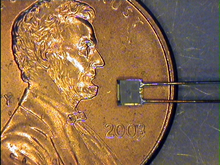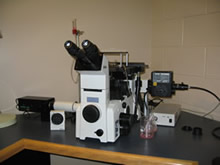MHTL Nano-related Research
Evaluation and Modeling of Next Generation Electronics Cooling Technologies |
|
| Sponsors: | 1. Nextreme Thermal Solutions |
| 2. Ontario Centres of Excellence | |
| Start Date: | January 1, 2007 |
Project Description: |
|
Experimental and Analytical Analysis of Micro-Channel Heat Exchangers |
|
| Sponsors: | 1. NSERC Discovery Grant |
| Start Date: | April 1, 2006 |
Project Description: |
|
Effective Thermal Conductivity of Composite Thermal Interface Materials |
Recent publications include: |

 Design and develop test procedures for evaluating the performance of Thermal Electric Components, including coefficient of performance (thermodynamic energy balance of heat energy removed versus electrical energy consumed), power generation capabilities, thermal conductivity and contact resistance.
Conduct laboratory testing to assess the thermal performance of new technologies for electronics cooling such as pulsating heat pipes, spray cooling, microchannel heat sinks and microjets. Enhance existing analytical simulation tools developed by the MHTL and design and implement new tools into a comprehensive suite of simulation tools that can be used by the electronics design community at large.
Design and develop test procedures for evaluating the performance of Thermal Electric Components, including coefficient of performance (thermodynamic energy balance of heat energy removed versus electrical energy consumed), power generation capabilities, thermal conductivity and contact resistance.
Conduct laboratory testing to assess the thermal performance of new technologies for electronics cooling such as pulsating heat pipes, spray cooling, microchannel heat sinks and microjets. Enhance existing analytical simulation tools developed by the MHTL and design and implement new tools into a comprehensive suite of simulation tools that can be used by the electronics design community at large.  Design, build, test and model micro-channel heat exchangers using nanofluids as the heat transfer fluid. Nanofluids consist of solid nano-particles, with sizes less than 100 nm, suspended in a liquid, with solid volume fractions typically less than 4%. This new class of heat transfer fluid has shown several attractive characteristics including the possibility of obtaining large enhancements (up to 40%) in thermal conductivity and significant increases in the convective heat transfer coefficient. Using commercially available components, a closed-loop cooling system will be constructed to evaluate the potential benefits of this new technology.
Design, build, test and model micro-channel heat exchangers using nanofluids as the heat transfer fluid. Nanofluids consist of solid nano-particles, with sizes less than 100 nm, suspended in a liquid, with solid volume fractions typically less than 4%. This new class of heat transfer fluid has shown several attractive characteristics including the possibility of obtaining large enhancements (up to 40%) in thermal conductivity and significant increases in the convective heat transfer coefficient. Using commercially available components, a closed-loop cooling system will be constructed to evaluate the potential benefits of this new technology.  Nano-scale particle-laden polymers are the latest Thermal Interface Materials (TIMs) being investigated for the minimization of thermal joint resistance in microelectronics applications. A fundamental problem which remains to be addressed is how to predict the effective thermal conductivity of these materials.
Nano-scale particle-laden polymers are the latest Thermal Interface Materials (TIMs) being investigated for the minimization of thermal joint resistance in microelectronics applications. A fundamental problem which remains to be addressed is how to predict the effective thermal conductivity of these materials. 